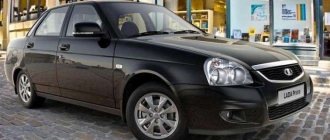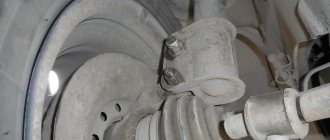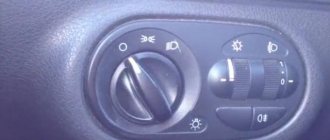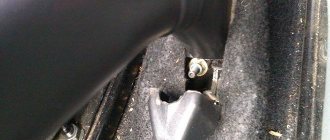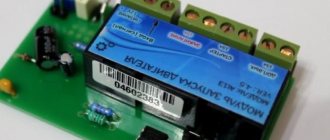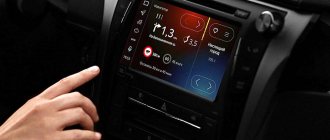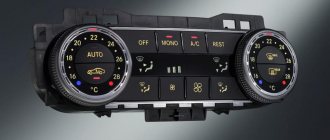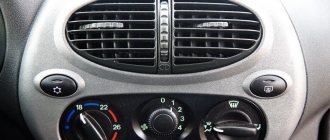It's no secret that modern cars are simply “stuffed” with all kinds of electronic systems to assist the driver. More recently, a car owner could be proud that his car is equipped with an anti-lock braking system (ABS), and the presence of an exchange rate stability system (ESP) put his vehicle on the same level as a spaceship or Mars rover. This is of course a joke, but it really reflects the state of things in the domestic automobile market in the 2000s.
Next, I will talk about an assistant that has recently become available to a wide range of motorists - launch control.
Launch control: what is it in a car?
Many owners of domestic and imported cars have heard of the concept of launch control. But few people know that this function is useful for cars used for transportation in everyday life, and is simply irreplaceable for racing cars. And even fewer car owners know what Launch Control is, how it works and how to use it.
What is launch control in a car?
Launch Control is an electronic system used in sports (racing) and production cars to enable a “quick start”. Using Launch Control allows you to effectively control a number of vehicle functions: injection system, ignition, throttle.
In mass-produced vehicles equipped with automatic transmission, Launch Control has not been used for a long time. This is due to the negative impact of high-speed starts on the automatic transmission. The launch control system began to be actively installed in cars after the creation and use of dual-clutch gearboxes on production cars. As a result, drivers of production cars have the opportunity to quickly start in urban conditions or on country roads.
Now Launch Control is installed on cars of a number of well-known world brands:
- BMW – M series of cars;
- Porsche – 911 and Panamera Turbo;
- Mitsubishi – Lancer Evolution X MR model;
- Nissan – GR-T model.
How launch control works
The operating principle of the launch control system is based on the ability of the car engine to maintain torque when the throttle is open and the clutch is depressed to the maximum. At the moment when the engine reaches a high number of revolutions, the driver stops holding the Launch Control pedal (button). This results in the removal of the rev limit and an immediate increase in torque.
In racing cars, the driver has the ability to manually control the number of revolutions before starting the car. But drivers of production cars are deprived of this opportunity - car manufacturers, wanting to protect the transmission from damage, set launch control parameters, as a result of which the number of revolutions is controlled automatically.
Robot only
For a long time, launch control was only available on cars with a manual transmission. On automatic machines with a torque converter, this is not possible, as there is a risk of damage to the torque converter. Now, with the introduction of preselective robotic boxes, launch control has been developed for them as well.
The most famous is the DSG gearbox on Volkswagen, which in a reinforced form is also available on sports models. Instead of a torque converter, there is a dual-clutch package, which copes much better with sudden starts.
Article on the topic
They came up with all sorts of things. Modern options in cars that scare beginners Therefore, the standard launch control mode can be seen on a number of Volkswagen cars. Such a box is now equipped with Scoda Octavia, Volkswagen Tiguan and other models with turbocharged engines.
The BMW M-series with a similar preselective robotic transmission has launch control. It is available not only on the Porsche 911 Turbo we tested, but also on the Panamera Turbo with the PDK Doppelkupplung sports robot.
According to Oleg Keselman, a driver who does not have special training in street racing can only achieve maximum rated acceleration on these cars using launch control.
Launch Control is one of the car's sport options
Most drivers, even if they have heard about such a function on cars as Launch Control, do not fully understand what it is.
Meanwhile, in motorsport, some time ago, it was in great demand, and even now discussions about its use on sports cars continue.
What is Launch Control for?
At the dawn of the development of motorsport, the standard of driver skill was considered to be their ability to take off quickly without losing traction of the wheels with the ground, since their “slippage” at high speeds led to a significant loss of time at the start.
The installation of electronic units on the cars, which made it possible to maintain optimal starting speeds, eliminating wheel slippage, with the gas pedal fully recessed, freed drivers from the need to improve their skills. At its core, Launch Control is the same launch master, but in electronic form.
How Launch Control was created
The creation of Launch Control began after engineers in 1985 learned to remotely receive signals from the sensors of their cars and transmit information to them that optimized the operation of individual systems. Two-way telemetry contributed to the further development of electronics, including the appearance of electronic units that control optimal speed at the start.
Because electronics have developed so rapidly that they have completely eclipsed the skill of racers, the International Automobile Federation (FIA) was forced to ban the use of Launch Control in Formula 1 racing. After some time, she again allowed their use, and in 2004 she banned them again, but for reasons of accessibility of these competitions for poor teams, since the development of new electronic systems requires significant financial investments.
Today, these systems are legal and very popular in short, quarter-mile "drag wrestling" events, in which a delay of even a hundredth of a second at the start will result in the loss of the race. They are also in demand among participants in amateur auto racing.
Tips for launching a mobile game: Part 1, Soft launch
In mobile games, a soft launch is often crucial - especially now, when app stores are oversaturated and you have to invest a lot of money to attract users.
Using a soft launch, you can understand how well the game will be received by users in the event of a global launch, and roughly estimate the costs of its marketing. However, a soft launch can be a time-consuming process - it is not always obvious what to do and what to avoid.
In 2022 alone, we at Nexon held a soft launch of about a dozen games. Through trial and error, we figured out what worked best for our games. Here are some of our best practices.
What is soft launch?
Soft launch occurs before the official launch of the game worldwide. Developers release the game in select regions similar to their target market in order to ensure a successful global launch. You can regard this as training or testing.
Checklist for soft launch
Define the main tasks
It is important to understand that soft launch is primarily a learning process. During this time, you prioritize speed and pure data over ROI, which you can focus on later during the global launch. Your main goal is to collect fast and clean data to make better business decisions later. This data will help you determine your betting strategy and map out your game's LTV curve.
Launch-control - what is it?
An educational article about the automatic injection and ignition control system called launch-control for the fastest possible start.
There is hardly a car enthusiast who has not heard of the Launch-control system. By electronically controlling the injection and ignition functions, as well as the throttle valve, the start can be optimized as much as possible, resulting in the full potential of the vehicle being realized. This is an extremely useful function, since there are many situations (not only when participating in races) when you need to start instantly.
Basic elements and capabilities of programs of this type
Now - just a first look at any Launch Manager. What it is is easy to determine (no matter what system it is designed for). The only thing worth noting here is that each of them has its own standard set of widgets that allow you to access certain functions.
What such toolkit is depends entirely on the software developer. But basically, there are several mandatory elements here, such as a volume control, a Wi-Fi or Bluetooth switch, settings for video mode and screen brightness, or the use of the so-called energy-saving mode (ECO).
Maximum acceleration. What is launch control and how does it work?
The launch control system is one of the most interesting options in the arsenal of sports cars. It helps you start as quickly as the car is capable of. Car racer and technical expert Oleg Keselman helps you figure out how to use it correctly .
Maximum turbine pressure
It's no secret that in the absence of accessible car tracks, the main sporting entertainment for street street racers is quarter-mile drag racing. The rules are simple. A straight and relatively uncongested section of the road is selected, and a platform is prepared for races with a temporary start and finish.
Naturally, the winning strategy here fits into one simple rule. Whoever starts better has a better chance of winning. And this can only be done when the engine reaches full power. A smooth start, as in everyday life, is not suitable here.
The clutch opens, and the engine with the turbocharger is spun up by gas to such speeds as to maintain full boost at the moment of start, that is, the maximum pressure of the turbine. Launch control is a great help here.
Electronic racer
We were able to test its effect on a Porsche 911 Turbo with a 540-horsepower boxer engine at the Moscow Raceway. The main straight of the track was divided into an acceleration and braking section with a dedicated quarter-mile section (402 m). On it we had to test the technology in action.
The theory says that the more momentum you give the car during the start, the faster it will accelerate. To do this, experienced racers, such as Oleg Keselman, first revved the engine to the red zone, and then threw the clutch pedal in such a way that the maximum torque immediately pushed the car off the ground and it flew out like a cannonball. Further acceleration must be accomplished without wheel slipping, so as not to waste energy. Great skill is required from the driver when operating the gas pedal.
The back of your head on the headrest
Before us is the main straight of Moscow Raceway in front of the high stands. We put the robotic gearbox selector in sport mode D, press the accelerator and hold the brake. You need to press on both pedals at once, and as hard as possible.
Photo: AiF/Vladimir Gavrilov
The engine revs up, roars, and the tachometer needle jumps to the red zone. The electronics itself controls the speed and prevents the engine from spinning up too much. The control unit interrupts signals to the ignition coils to keep it in the maximum power range.
Then we release the brake and the clutch suddenly engages. The Porsche 911 Turbo rushes forward with a wild roar, so much so that you painfully hit the back of your head against the headrest.
At this moment, you need to continue to press the accelerator, without fear that the engine has a power of 540 hp. With. will cause the wheels to slip. The electronics will allow only small slippage and will not allow the power unit to develop more power than is needed for acceleration. As a result, electronics, and not humans, control the process of gaining speed.
Photo: AiF/Vladimir Gavrilov
Video on the topic
Launch control is a subsystem of electronic control of the throttle valve, injection and ignition systems, designed for a sharp start from a standstill.
History of launch control creation
The need to start as quickly as possible and without losing traction of the wheels with the road arose, obviously, in the first automobile race in the history of mankind. For a long time, before the advent of the first microprocessor systems that made it possible to control the operating parameters of various car systems, the optimal start was considered part of the racer's art of using various techniques.
It all started with two-way telemetry. In 1985, Renault team engineers learned not only to remotely receive signals from the sensors of a car on the track, but also to transmit other signals that optimize the operation of a number of systems.
Later, when electronic systems reached a high level of development, the Fédération Internationale de l'Automobile (FIA) banned the use of “electronic assistants” by Formula 1 teams under the pretext that the driver’s skill recedes into the background if they are present. After much debate, the use of two-way telemetry systems was again allowed, and then again prohibited in 2004, since, in the opinion of the FIA, excessive use of electronics requires too much development costs for new systems, which prevents the effective participation in low-budget racing. commands
Why do you need launch control?
In other types of racing, where the problem of effective starting is no less pressing, and the rules do not prohibit the use of electronics, launch control systems are actively used. An excellent example of such racing is quarter-mile speed racing, the so-called “drag racing”. The specificity of these races is that the competition is fought over hundredths of a second, and if a participant loses at the start, he automatically loses the race. Therefore, launch control systems are extremely popular among drag competition participants.
Launch control used when building a drag racing car is quite simple and at the same time effective. It allows you to start under almost identical conditions in each race. When setting up launch control, the rider must set the level of engine speed that the electronic control system will maintain until the very moment of start. This allows the driver to press the accelerator pedal to the limit (and immediately after the start, full throttle opening will be required immediately, since it will be necessary to accelerate by “squeezing” out of the car everything that it is capable of), and the engine speed will not change before the start.
The choice of optimal speed depends on many factors and, of course, on understanding the characteristics of a particular car. When choosing, you should take into account the nature of the surface, tires, suspension settings and a number of other factors.
When operating a car equipped with an engine with a turbocharger, when choosing revolutions, it is necessary to take into account the nature of turbo lag and set the start conditions after the engine reaches full boost (in this case, launch control should not be confused with anti-lag).
How launch control works
